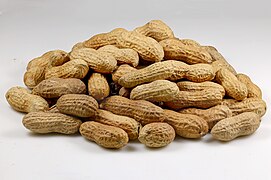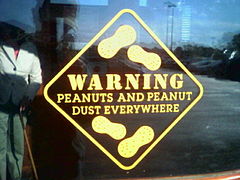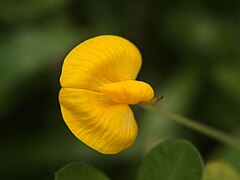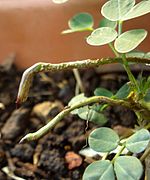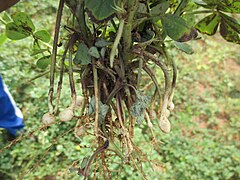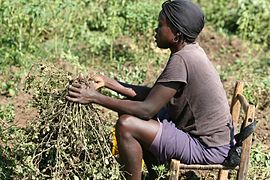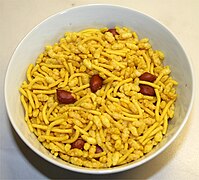Simli: Waligimsim din be labiteei balibu ni.
Clean up |
Clean up |
||
| Kuligu 106: | Kuligu 106: | ||
* United States. Bureau of Agricultural Economics. ''Peanuts in southern agriculture'' (1947) [https://archive.org/details/peanutsinsouther65unit/page/n2/mode/1up online] |
* United States. Bureau of Agricultural Economics. ''Peanuts in southern agriculture'' (1947) [https://archive.org/details/peanutsinsouther65unit/page/n2/mode/1up online] |
||
* Variath, Murali T., and P. Janila. "Economic and academic importance of peanut." in ''The peanut genome'' (2017): 7-26. [http://oar.icrisat.org/10492/1/Economic%20and%20Academic%20Importance.pdf online] |
* Variath, Murali T., and P. Janila. "Economic and academic importance of peanut." in ''The peanut genome'' (2017): 7-26. [http://oar.icrisat.org/10492/1/Economic%20and%20Academic%20Importance.pdf online] |
||
[[Pubu:Lahabaya zaa]] |
|||
==External links== |
|||
{{Commons}} |
|||
{{Nuts}} |
|||
{{Taxonbar|from=Q37383}} |
|||
{{Authority control}} |
|||
[[Category:Peanuts| ]] |
|||
[[Category:Arachis]] |
|||
[[Category:Convenience foods]] |
|||
[[Category:Crops originating from indigenous Americans]] |
|||
[[Category:Crops originating from South America]] |
|||
[[Category:Crops]] |
|||
[[Category:Edible legumes]] |
|||
[[Category:Edible nuts and seeds]] |
|||
[[Category:Nitrogen-fixing crops]] |
|||
[[Category:Oil seeds]] |
|||
[[Category:Plants described in 1753]] |
|||
[[Category:Snack foods]] |
|||
[[Category:Taxa named by Carl Linnaeus]] |
|||
[[Pubu:Bimbilli]] |
[[Pubu:Bimbilli]] |
||
Labiyuli kamani 15:05, 3 Silimin gɔli September 2024
| Yaɣ sheli | useful plant, annual plant |
|---|---|
| Di bukaata | fodder, medicinal plant, vegetable, mɔli, cooking oil |
| Yu'ŋmaa | A. hypogaea |
| Nangban yiŋga Yuya | Arachis hypogaea |
| Yaɣili Kpamli | species |
| Lamba Zuliya | Arachis |
| This taxon is source of | peanut, peanut protein, peanut flour, peanut shell, peanut oil |
| NatureServe conservation status | secure |
| Nahingbaŋ | phosphorescence |
| Hardiness of plant | 2 |
| Taxon range | Beijing, China, Fujian, Tibet Autonomous Region, Guangdong |
| Taxon author citation | L. |
| GRIN URL | https://npgsweb.ars-grin.gov/gringlobal/taxonomydetail.aspx?id=3785 |
| Sequenced genome URL | https://www.dnazoo.org/assemblies/Arachis_hypogaea |
Simli[1]nyɛla binbela bee bimbila bal'shɛli, ka di kɔri ŋa dunia bɔba ni di yaɣa.[2] Di boonila di zaɣ' yini simli ka di zaɣ' bɔbigu mi nyɛ sima.[3][4][5] [4] Sima nyɛla bimbili shɛli ninsali nima ni kɔra dira. Di nyɛla bimbili shɛli bɛ ni kɔri pam mini bela bela bɔba ni yaɣa zaa[6] ka nyɛ bɛ ni lahi mali shɛli niŋdi kpam.[7] Di binwɔlli nyɛla din niŋdi tiŋgbani ni ka di zuɣu che ka tabibi baŋda Carl Linnaeus daa boli hypogaea ka di gbuuni nyɛ tiŋgbani gbunni.
Simli ŋɔ nyɛla din be tabibi daŋ yuli booni Fabaceae bee Leguminosae ka pirigili tooi booni "pea" daŋ.[8] Kamani bimbila kam din be di daŋ ŋɔ ni, di nyɛla din mali binshɛli di puuni ka di pahiri tam,[9] ka di che ka niriba pam kpaŋsi bimbilima kɔri ka taɣara
Pirimila di bi lu zahim di tabibi yuli ŋɔ zuɣu, di binwɔlli maa nyɛla din kpɛma pam di yi ti niŋ ka di bi. [10]

Taarihi
Sima bal' shɛli Silimiinsi ni boli "Arachis" nyɛla din yina South America, Aedes wulinluhili polo, zaŋ chaŋ Peru, Bolivia, Argentina, ni Brazil.[11] Sima balishɛli din nyɛ a. hypogaea nyɛla din yina sima balibu dibaa ayi puuni, dini n-nyɛ "A. duranensis" mini "A. ipaensis".[11][12][13][11][14][11][12]
Botany

Simli ŋɔ nyɛla bimbili shɛli din niŋdi yuun yini puuni ka nyɛ din waɣilim paai kamani cɛntimita pihita zaŋ chaŋ cɛntimita pihinu.[15] Di nyɛla din be tabibi daŋ yuli booni Fabaceae ka shɛba lahi booni Leguminosae, niriba pam nyɛla ban booni "pea" daŋ.[8] Kamani lala bimbila daŋ ŋɔ, simli din nyɛla din niŋdi di bimwalla tiŋgbani gbunni.[9]
Di puma maa nyɛla din waɣilim be kamani cɛntimita zaɣ'yini zaŋ chaŋ zaɣ'yini ni pirigili ka di puma maa kom nyɛ dɔzim.[14][15] Di nyɛla din be simli ŋɔ zuɣuzaa ka nyɛ din be di ni kamani dabisi yini zuɣu.[16]
Animal feed
Simli bimbili zuɣuzaa maa nyɛla bɛ ni tooi yunsi shɛli leei "silage".[17]
Di vari ŋɔ nyɛla bɛ ni mali shɛli tiri binkɔbiri ka bɛ ŋubira ka lahi mali pahiri tam. "Groundnut cake" nyɛla bindirigu zaŋ n-ti niɣi.[18] Di nyɛla bindiri shɛŋa din mali anfaani zaŋ n-ti binkɔbiri zaɣ'yini ka tiriba alaafee.[19] Di yi niŋ ka lala bindirigu ŋɔ bi nya zani suŋ di nyɛla binshɛli dɔro booni "aflatoxin" ni tooi kpɛ shɛli ni ka di nyɛ di ni tooi tahi "Aspergilus flavus" mini "Aspergilus parasiticus".[20] Lala bindirigu ŋɔ nyɛla din sɔŋdi binkɔbiri ka bɛ zoora ka nyɛ din mali kpam gba di puuni.[citation needed]
Sim'shɛŋa gba nyɛla bɛ ni tooi zaŋ shɛli leei bindirigu zaŋ n-ti binkɔbiri.[21]
Saha shɛŋa bɛ nyɛla ban nimdi sima ŋɔ ka di leeri zim pɔi ka bɛ mali li n-tiri binkɔbiri di gbaai bahindi binkɔbi shɛba ban puya anahinahi.[22]
Cultivation
Sima nyɛla bɛ ni tooi kɔri shɛli tamkpaɣu zim ni din tam nyɛ pH zaŋ n-ti 5.9–7. Sima nyɛla din sɔŋdi tamkpaɣu kulim.[23] Lala zuɣu di nyɛla din kpa talahi bimbira taɣi gili biri ni. Yaha sima yam gba nyɛla din pahiri tam kulim ka boori dɔriti mini mɔri yɛligibu. Ŋmahinli Texas, sima din be yuma ata bimbila kɔn taɣi ni kawaana nyɛla din yɛn niŋ viɛnyɛla kamani kɔbigi puuni vaabu pihinu gari sim'shɛŋa din bi kɔri ka taɣiri ni kawaana.[23] Tabibi binyɛri shɛŋa mini tiŋgbani binneen bihi nyɛla din sɔŋ sima viɛnyɛla niŋbu .[23] Sima nyɛla din bori tulim bela di piligu zaŋ hali ni di niŋbu ni din yɛn che ka di tooi niŋ viɛnyɛla. Di nyɛla niri ni tooi kɔ shɛli ni kom din nyɛ 350 mm (14 in) ,[24] amaa di viɛnyɛla zaa nyɛla 500 mm (20 in).[25] Di doli la simli maa ni nya kom shɛm sanzali, lala tiŋgbani maa tam ni din kam pahi, sima ni tooi kɔn kpuɣi biɛɣ'pihiwɔi zaŋ chaŋ biɛɣ'kɔbigi ni pihita niri yi biri li nyaaŋa ka sim'shɛŋa din mabiligu nyɛ A. h. hypogaea nyɛ din zaŋdi biɛɣ'kɔbigi ni pishi zaŋ chaŋ biɛɣ'kɔbigi ni pihinu sunsuun .[24][26][27] Di mabiligu din nyɛ A. h. hypogaea nyɛ din niŋdi pam ka bɛ tooi kpaŋsiri niriba di kɔbu luɣishɛŋa saa ni miri yuura.

Simli bimbili nyɛla din kuli niŋdi puma saha kam saha shɛli di yi ti piligi walla niŋbu ka lala zuɣu che ka sima ŋɔ shɛŋa bɛ bira hali di kpuɣibu saha yi ti paagi. Niri yi bori ni a kɔ sima nya pam di kpuɣibu saha ŋɔ nyɛ din kpa talahi. Di yi niŋ ka niri kɔ sima ka daŋli kpuɣibu pɔi ni di saha sima maa nyɛla din na bɛn bii, nirimi yi lahi yuugi di kpuɣibu din bili yaha.[28] Niri yi yɛn kɔn kpuɣi sima di bimbili maa zaa mini di gbunni wɔla maa zaa nyɛla bɛ ni yihiri shɛli na tankpaɣu ni.[28] Sim'pɔɣiri nyɛ pɔbi sim'bilim ŋɔ.
Bin'shɛŋa din tooi che ka sima bi niŋdi pam nyɛ sanzali mini tulim pam ti yaɣi .[29]

Sima kɔn kpuɣi nyɛla ʒibuyi.[30] Lɛbiginsim ni be luɣishɛŋa maa bɛ mali la maʒini nima sibiri sima ŋɔ. Maʒini ŋɔ nyɛla din yɛn ŋmaai din gbunni jila maa tariga ka yihi di mini tankpaɣu na. Di nyaaŋa bɛ yɛn che la sima ŋɔ sɔŋ dabaa ata zaŋ chaŋ dabaa anahi sunsuun ka di kuui pɔi ka bɛ naayi pɛli. Luɣishɛŋa lɛbiginsim ni na kani nuhi ka bɛ mali sibiri sima ŋɔ.[28] .
Di daafaan' nima
Sima nyɛla din binbela shɛli ŋan mali bukaatanima pam n-ti ninsalinima, binkɔbiri ni tingbani shɛli din mali kɔrili maa.
- Sima nyɛla din mali shɛli doori kpam
- Di nyɛla daadama ni ŋubiri binshɛli, di zaɣ'kaha, din chim, din waagi bee di din shɛ, ka di nyɛ bindirigu.
Pests and diseases
Di yi ti niŋ ka simli bimbila nya sanzali saha shɛli di wɔla ŋɔ niŋda bee ka di bi niŋ naai, di nyɛla din yɛn gbaai dɔri shɛli beni bɛ booni li "mold Aspergilus flavours" ka di ni tooi che ka di bi niŋ viɛnyɛlla. Sim' shɛli sanzali ni zabi pam ni dɔro ni gbaai nyɛla din bi niŋ di paari dini di yɛn niŋ shɛm.[31] United States tuma duu zaŋ n-ti pukparilim nyɛla ban daa niŋ vihigu zaŋ chaŋ dɔro yi gbaai simli yaɣa kamani pinaanu nyɛla di ni yɛn saɣim simli maa zaa. Lala tuma duu ŋɔ nyɛla ban m-bo so shɛŋa bɛ ni yɛn niŋ shɛm gu ka taɣi lala sima dɔriti ŋɔ.[32]Sim' shɛŋa bɛ ni nya ka dɔro mali nyɛla bɛ ni tooi mali shɛli niŋdi kpam din yɛn che ka bɛ yihi lala dɔro ŋɔ.[33]
Bimbili ŋɔ vari gba nyɛla dɔri shɛli beni ka bɛ booni li "Alternaria arachidis' ni tooi gbaai.[34]
Anfooninima
-
Roasted Peanuts with shell
-
A warning sign for the presence of peanuts and peanut dust
-
Arachis hypogaea flower
-
Peanut pegs penetrating the ground
-
Textural detail
-
Closeup of Peanuts, selling in India.
-
Developing pods of peanut
-
Track-type peanut harvester
-
Harvesting peanuts by hand (Haiti, 2012)
-
A bowl of sev mamra, consisting of puffed rice, peanuts and fried seasoned noodles
Lihimi m-pahi
Kundivihira
- ↑ Naden, Tony. 2014. Dagbani dictionary. Webonary.
- ↑ The European market potential for groundnuts | CBI.
- ↑ USDA GRIN Taxonomy, retrieved 29 June 2016
- ↑ 4.0 4.1 Domonoske, Camila (April 20, 2014). "A Legume With Many Names: The Story Of 'Goober'". National Public Radio. https://www.npr.org/sections/codeswitch/2014/04/20/304585019/a-legume-with-many-names-the-story-of-goober.
- ↑ Beattie, H. R. (1911). Farmer's Bulletin No. 431. "The peanut is known under the local names of "goober," "goober pea," "pindar," "ground pea," and "groundnut." The names "goober" and "goober pea" are more properly applied to an allied species having no true stem and only one pea in each pod which has been introduced and is frequently found growing wild in the Gulf Coast States."
- ↑ Hymowitz, Theodore . (1990). "Grain Legumes". In Janick, J.; Simon, J.E. (eds.). Advances in new crops. Portland, Oregon: Timber Press. pp. 54–57.
- ↑ Oil crops for the production of advanced biofuels.
- ↑ 8.0 8.1 A chirim ya: Invalid
<ref>tag; no text was provided for refs namedWFO - ↑ 9.0 9.1 Legumes Of The World | Royal Botanic Gardens, Kew.
- ↑ The Peanut Institute – Peanut Facts. peanut-institute.org.
- ↑ 11.0 11.1 11.2 11.3 (December 1, 2007) "Genomic relationships between the cultivated peanut (Arachis hypogaea, Leguminosae) and its close relatives revealed by double GISH". American Journal of Botany 94 (12): 1963–1971. DOI:10.3732/ajb.94.12.1963. ISSN 0002-9122. PMID 21636391.
- ↑ 12.0 12.1 (October 1, 1996) "RFLP and Cytogenetic Evidence on the Origin and Evolution of Allotetraploid Domesticated Peanut, Arachis hypogaea (Leguminosae)". American Journal of Botany 83 (10): 1282–1291. DOI:10.2307/2446112.
- ↑ (January 1, 2013) "A study of the relationships of cultivated peanut (Arachis hypogaea) and its most closely related wild species using intron sequences and microsatellite markers". Annals of Botany 111 (1): 113–126. DOI:10.1093/aob/mcs237. ISSN 0305-7364. PMID 23131301.
- ↑ 14.0 14.1 (2007) "Taxonomy of the genus Arachis (Leguminosae)". IBONE 16 (Supl.): 1–205.
- ↑ 15.0 15.1 A chirim ya: Invalid
<ref>tag; no text was provided for refs namedputnam - ↑ Smith, Ben W. (January 1, 1950). "Arachis hypogaea. Aerial Flower and Subterranean Fruit". American Journal of Botany 37 (10): 802–815. DOI:10.2307/2437758.
- ↑ Heuzé V., Thiollet H., Tran G., Lebas F., 2017. Peanut forage. Feedipedia, a program by INRA, CIRAD, AFZ, and FAO. https://www.feedipedia.org/node/695 Archived Silimin gɔli August 24, 2017, at the Wayback Machine
- ↑ Deshpande, S. S. (2000). Fermented Grain Legumes, Seeds and Nuts. Food & Agriculture Org. ISBN 9789251044445. Retrieved May 25, 2015.
- ↑ Palm kernel meal as a feed for poultry. 1. Composition of palm. Journal of Animal feed science.[permanent dead link]
- ↑ 3. Feed values and feeding potential of major agro-byproducts. fao.org.
- ↑ Heuzé V., Thiollet H., Tran G., Bastianelli D., Lebas F., 2017. Peanut seeds. Feedipedia, a program by INRA, CIRAD, AFZ, and FAO. https://www.feedipedia.org/node/55 Archived Silimin gɔli August 24, 2017, at the Wayback Machine
- ↑ Heuzé V., Thiollet H., Tran G., Edouard N., Bastianelli D., Lebas F., 2017. Peanut hulls. Feedipedia, a program by INRA, CIRAD, AFZ, and FAO. https://www.feedipedia.org/node/696 Archived Silimin gɔli August 24, 2017, at the Wayback Machine
- ↑ 23.0 23.1 23.2 Baughman, Todd; Grichar, James; Black, Mark; Woodward, Jason; Porter, Pat; New, Leon; Baumann, Paul; McFarland, Mark "Texas Peanut Production Guide Archived Silimin gɔli March 4, 2016, at the Wayback Machine" (PDF). Texas A&M University. Retrieved October 16, 2015,
- ↑ 24.0 24.1 Schilling, Robert (February 5, 2003). L'arachide histoire et perspectives. Agropolis Museum.
- ↑ Jauron, Richard (February 5, 1997). Growing Peanuts in the Home Garden | Horticulture and Home Pest News. Ipm.iastate.edu.
- ↑ New Mexico Peanut Production. New Mexico State University (July 2009).
- ↑ Peanut.
- ↑ 28.0 28.1 28.2 How peanuts are Grown – Harvesting – PCA. Peanut Company of Australia.
- ↑ Willy H. Verheye, ed. (2010). "Growth and Production of Groundnuts". Soils, Plant Growth and Crop Production Volume II. EOLSS Publishers. p. 153. ISBN 978-1-84826-368-0.
- ↑ Bilello, Stanley (October 10, 2016). 21st Century Homestead: Nitrogen-Fixing Crops (in English). Lulu.com. pp. 93–94. ISBN 9781365452901.Tɛmplet:Self-published source
- ↑ (August 2001) "[Proportion of aflatoxin B1 contaminated kernels and its concentration in imported peanut samples]". Shokuhin Eiseigaku Zasshi 42 (4): 237–42. DOI:10.3358/shokueishi.42.237. PMID 11817138.
- ↑ 7 CFR 2011 – Part 996aTɛmplet:Full citation needed
- ↑ Why Georgia farmers decided to shell their own peanuts (en-CA) (April 26, 2017).
- ↑ Species Fungorum - Names Record.
Further reading
- Beasley, John. "Peanuts." New Georgia Encyclopedia (2019) online; 49% of the American peanut crop is grown in the state of Georgia.
- Cumo, Christopher, ed. Foods That Changed History: How Foods Shaped Civilization from the Ancient World to the Present (Facts on File, 2015) online
- Hammons, R. O. "The origin and history of the groundnut" in The groundnut crop: a scientific basis for improvement (Springer Netherlands, 1994) pp. 24-42.
- Hughes, Meredith Sayles. Spill the Beans and Pass the Peanuts: Legumes (Lerner, 1999).
- Johnson, Sylvia A. Tomatoes, Potatoes, Corn, and Beans: How the Foods of the Americas Changed Eating around the World (Atheneum Books, 1997). online
- Krampner, Jon. Creamy and Crunchy: An Informal History of Peanut Butter, the All-American Food (Columbia University Press, 2013).
- Singh, B., and U. Singh. "Peanut as a source of protein for human foods." Plant Foods for Human Nutrition 41 (1991): 165-177. online
- Skolnick, Helen S., et al. "The natural history of peanut allergy." Journal of allergy and clinical immunology 107.2 (2001): 367-374. online
- Smart, J. The Groundnut Crop: A Scientific Basis for Improvement (Chapman and Hall, 1994)
- Smith, Andrew F. Peanuts: The illustrious history of the goober pea (University of Illinois Press, 2002).
- United States. Bureau of Agricultural Economics. Peanuts in southern agriculture (1947) online
- Variath, Murali T., and P. Janila. "Economic and academic importance of peanut." in The peanut genome (2017): 7-26. online
- Peejinima din kundivira bi viɛla
- Webarchive template wayback links
- All articles with dead external links
- Articles with dead external links from August 2024
- Articles with invalid date parameter in template
- Articles with permanently dead external links
- CS1 English-language sources (en)
- Pages using PMID magic links
- All articles with unsourced statements
- Articles with unsourced statements from December 2019
- Lahabaya zaa
- Bimbilli
- Stubs

